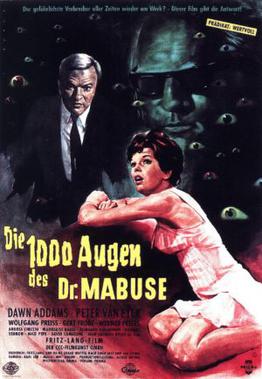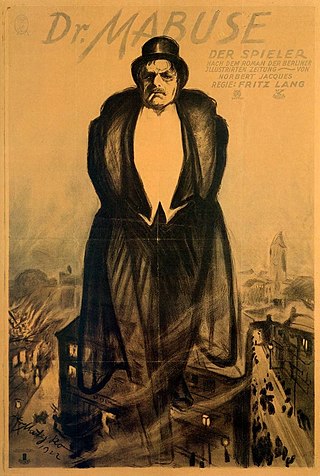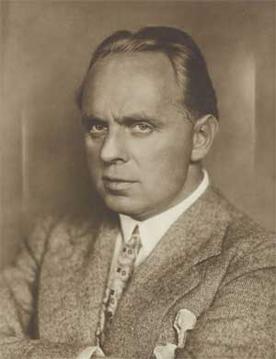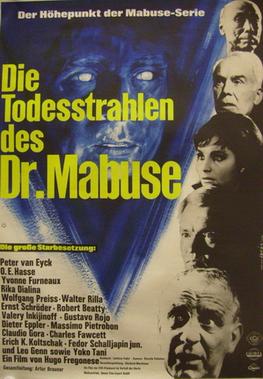
Friedrich Christian Anton Lang, better known as Fritz Lang, was an Austrian-American film director, screenwriter, and producer who worked in Germany and later the United States. One of the best-known émigrés from Germany's school of Expressionism, he was dubbed the "Master of Darkness" by the British Film Institute. He has been cited as one of the most influential filmmakers of all time.

Dr. Mabuse is a fictional character created by Norbert Jacques in his 1921 novel Dr. Mabuse, der Spieler, and his 1932 follow-up novel Das Testament des Dr. Mabuse (1932). The character was made famous by three films about the character directed in Germany by Fritz Lang: Dr. Mabuse the Gambler, The Testament of Dr. Mabuse (1933), and the much later The Thousand Eyes of Dr. Mabuse (1960). Five other films featuring Dr. Mabuse were made by other directors in Germany in the early 1960s, followed by Jess Franco's interpretation The Vengeance of Dr. Mabuse in 1971.

The Testament of Dr. Mabuse, also called The Last Will of Dr. Mabuse, is a 1933 German crime-thriller film directed by Fritz Lang. The movie is a sequel to Lang's silent film Dr. Mabuse the Gambler (1922) and features many cast and crew members from Lang's previous films. Dr. Mabuse is in an insane asylum where he is found frantically writing his crime plans. When Mabuse's criminal plans begin to be implemented, Inspector Lohmann tries to find the solution with clues from gangster Thomas Kent, the institutionalized Hofmeister and Professor Baum who becomes obsessed with Dr. Mabuse.
Wolfgang Preiss was a German theatre, film and television actor.
Edgar Wallace (1875–1932) was a British novelist, playwright and screenwriter whose works have been adapted for the screen on many occasions. His films fall into two categories, British adaptations and the German "Krimi" films.

The Thousand Eyes of Dr. Mabuse is a 1960 black-and-white crime thriller film directed by Fritz Lang in his final film. A West German/French/Italian international co-production, it starred Peter van Eyck, Dawn Addams and Gert Fröbe. The film made use of the character Dr. Mabuse, who had appeared in earlier films by Lang in 1922 and 1933. The Thousand Eyes of Dr. Mabuse spawned a film series of German Mabuse films that were released over the following years to compete with Rialto Film's Krimi films.

Dr. Mabuse the Gambler is the first film in the Dr. Mabuse series about the character Doctor Mabuse who featured in the novels of Norbert Jacques. It was directed by Fritz Lang and released in 1922. The film is silent and would be followed by the sound sequels The Testament of Dr. Mabuse (1933) and The Thousand Eyes of Dr. Mabuse (1960).

Friedrich Rudolf Klein, better known as Rudolf Klein-Rogge, was a German film actor, best known for playing sinister figures in films in the 1920s and 1930s as well as being a mainstay in director Fritz Lang's Weimar-era films. He is probably best known in popular culture, particularly to English-speaking audiences, for playing the archetypal mad scientist role of C. A. Rotwang in Lang's Metropolis and as the criminal genius Doctor Mabuse. Klein-Rogge also appeared in several important French films in the late 1920s and early 1930s.

Artur "Atze" Brauner was a German film producer and entrepreneur of Polish origin. He produced more than 300 films from 1946.

The Indian Tomb is a 1959 adventure film, co-written and directed by Fritz Lang. Produced by Artur Brauner, it is an international co-production of West Germany, France and Italy. It is the second film, after The Tiger of Eschnapur (1959), that comprise "Fritz Lang's Indian Epic" duology, which are based on the 1918 novel Das indische Grabmal, written by Lang's ex-wife Thea von Harbou.

Scotland Yard Hunts Dr. Mabuse or Scotland Yard vs. Dr Mabuse is a 1963 German crime film directed by Paul May and starring Peter van Eyck. Scotland Yard vs. Dr. Mabuse was distributed in West Germany by Gloria Film, premiering on 20 September 1963. The film was written by Ladislas Fodor, based on a story idea written by Bryan Edgar Wallace. It was shot at the Spandau Studios in Berlin. The film's sets were designed by the art directors Albrecht Hennings and Hans Kuhnert.

Norbert Jacques was a Luxembourgish novelist, journalist, screenwriter, and translator who wrote in German. He was born in Luxembourg-Eich, Luxembourg and died in Koblenz, West Germany. He created the character Dr. Mabuse, who was a feature of some of his novels. Dr. Mabuse, der Spieler, the first novel to feature Mabuse, was one of the bestsellers of its time; it sold over 500,000 copies in Germany. Today, Jacques is known best for Dr. Mabuse. In 1922, he received German citizenship.

Karl Adolf Kurt Werner Klingler was a German film director and actor. He directed 29 films between 1936 and 1968. He was born in Stuttgart and died in West Berlin, West Germany.
Nero-Film AG was a German film production company founded in 1925 and based in Berlin during the Weimar era.

Die Nibelungen is a 1966/1967 West German fantasy film released in two parts, Siegfried von Xanten and Kriemhilds Rache. It was directed by Harald Reinl and produced by Artur Brauner. Die Nibelungen starred Uwe Beyer, Karin Dor and Herbert Lom. The two films were a remake of Fritz Lang's 1924 silent classic Die Nibelungen, which was in turn based on the epic poem the Nibelungenlied.

The Return of Doctor Mabuse is a 1961 black-and-white crime film/thriller made in West Berlin. It was a West German/French/Italian international co-production directed by Harald Reinl that was the second of the 1960s CCC Films Dr. Mabuse film series, being the sequel to Fritz Lang's The Thousand Eyes of Dr. Mabuse (1960). It starred Gert Fröbe, Daliah Lavi and in his first German film, Lex Barker. The film was co-written by Ladislas Fodor and, in his first screenplay, Marc Behm. They created a science fictional plot that would be followed in the other films in the series.

The Secret of Dr. Mabuse or The Death Ray of Dr. Mabuse is a 1964 Franco-German-Italian international co-production science fiction Eurospy crime film directed by Hugo Fregonese and Victor De Santis and starring Peter van Eyck, O.E. Hasse and Yvonne Furneaux. It was a co-production between France, Italy and West Germany. The film was the last in a series of films which had revived the Weimar era character Doctor Mabuse.

La venganza del Doctor Mabuse is a 1972 film directed by Jesús Franco. The film is about the character Dr. Mabuse, a who is plotting a comeback from his secret base in the United States. Mabuse has learned how to control the minds of others through a form of radiation emitted by samples of moon rocks.















